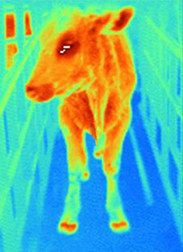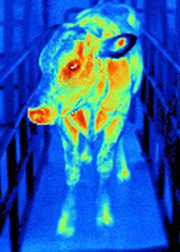This page has been archived and is being provided for reference purposes only. The page is no longer being updated, and therefore, links on the page may be invalid.
|
Read the magazine story to find out more. |
|
|
|
|
Technologies Improve FMD Detection and Control
By Laura McGinnisApril 23, 2009
Improving the detection and control of foot and mouth disease (FMD) in cattle could result from technology being developed and tested by Agricultural Research Service (ARS) scientists.
The United States hasn't had an outbreak of FMD since 1929, but being prepared for an outbreak is a priority for the U.S. government.
One study used infrared cameras to detect elevated hoof temperatures, a symptom of FMD in cattle. That work was conducted by research leader Luis Rodriguez, microbiologist Juan Pacheco and research fellow Kaitlin Rainwater-Lovett with ARS at the Plum Island Animal Disease Center at Orient Point, N.Y., in collaboration with University of Minnesota biologist Craig Packer.
Infrared technology could detect elevated temperatures up to two days before cattle develop clinical signs. Cheaper and faster than existing screening methods, this technology could allow scientists and veterinarians to identify potentially infected cattle in large groups, without examining animals individually.
The ARS scientists have also collaborated with the biotechnology company Tetracore to develop a test that can detect RNA from the FMD virus in less than two hours. In the event of an FMD emergency, laboratories throughout the United States could use this technology to diagnose samples rapidly.
In related work, ARS chemist Marvin Grubman and his colleagues are making improvements to the FMD vaccine they developed. The vaccine can be produced without using infectious FMD materials, which means it can be produced on the U.S. mainland without the need for expensive, high-containment production facilities.
Tests have shown that the vaccine becomes effective a mere seven days after it's been administered. Although this is one of the fastest vaccines available, Grubman and his colleagues wanted faster protection. After all, a lot can happen in seven days, particularly during an outbreak. In a recent study, Grubman found that proteins called interferons can offer protection while animals are developing an antibody response to the vaccine, increasing their resistance.
ARS, the U.S. Department of Homeland Security and biopharmaceutical company GenVec, Inc., in Gaithersburg, Md., are now collaborating to develop the new FMD vaccine for inclusion in the U.S. Veterinary Vaccine Stockpile. They are also working to combine the interferons and the FMD vaccine so they can be administered concurrently.
Read more about this research in the April 2009 issue of Agricultural Research magazine.
ARS is the principal intramural scientific research agency of the U.S. Department of Agriculture.


